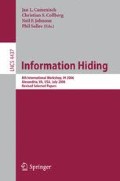Abstract
In this paper we focus on estimating the amount of information that can be embedded in the sequencing of packets in ordered channels. Ordered channels, e.g. TCP, rely on sequence numbers to recover from packet loss and packet reordering. We propose a formal model for transmitting information by packet-reordering. We present natural and well-motivated channel models and jamming models including the k-distance permuter, the k-buffer permuter and the k-stack permuter. We define the natural information-theoretic (continuous) game between the channel processes (max-min) and the jamming process (min-max) and prove the existence of a Nash equilibrium for the mutual information rate. We study the zero-error (discrete) equivalent and provide error-correcting codes with optimal performance for the distance-bounded model, along with efficient encoding and decoding algorithms. One outcome of our work is that we extend and complete D. H. Lehmer’s attempt to characterize the number of distance bounded permutations by providing the asymptotically optimal bound - this also tightly bounds the first eigen-value of a related state transition matrix [1].
Access this chapter
Tax calculation will be finalised at checkout
Purchases are for personal use only
Preview
Unable to display preview. Download preview PDF.
References
Lehmer, D.H.: Permutations with strongly restricted displacements. In: Erdös, P., Renyi, A., Sós, V. (eds.) Combinatorial theory and its applications II, pp. 755–770 (1970)
Shannon, C., Weaver, W.: The Mathematical Theory of Communication. University of Illinois Press, Urbana, Illinois (1949)
Blake, I.F.: Permutation codes for discrete channels (corresp.). IEEE Trans. Inform. Theory 20, 138–140 (1974)
Schulman, L.J., Zuckerman, D.: Asymptotically good codes correcting insertions, deletions, and transpositions. IEEE Trans. Inform. Theory 45(7), 2552–2557 (1999)
Ahsan, K., Kundur, D.: Practical data hiding in TCP/IP (2002), [Online]. available http://citeseer.ist.psu.edu/ahsan02practical.html
Karlin, S.: Mathematical Methods and Theory in Games, Programming and Economics.Dover, TODO year, vol. 2, ch. Some chapter TODO
Steganographic communication in ordered channels (2006), [Online]. available http://abishekk.googlepages.com/stego.pdf
Mendelsohn, N.S.: Permutations with confined displacements. Canadian Math. Bulletin 4, 29–38 (1961)
Mendelsohn, N.S.: The asymptotic series for a certain class of permutation problems. Candian Jour. Math. B. 8, 234–244 (1956)
Campbell, W.H.: Indexing permutations. J. Comput. Small Coll. 19(3), 296–300 (2004)
Egorychev, G.: The solution of Van der Waerden’s problem for permanents. Advances in math 42, 299–305 (1981)
Knuth, D.E.: Fundamental Algorithms. In: The Art of Computer Programming, 2nd edn. vol. 1(1.2), pp. 10–119. Addison-Wesley, Reading, Massachusetts (1973)
Diaconis, P., Graham, R., Holmes, S.P.: Statistical problems involving permutations with restricted positions. Festschrift in Honor of William van Zwet (1999), [Online]. available: http://www-stat.stanford.edu/~susan/papers/perm8.ps
Deza, M., Huang, T.: Metrics on permutations, a survey. Journal of combinatorics, Information and System Sciences (1998), [Online]. available: http://www.liga.ens.fr/~deza/papers/voldpapers/huang/huangperm.pdf
Zeckendorf, E.: Representation des nombres naturels par une somme de nombres de fibonacci ou de nombres de lucas. Bull. Soc. Roy. Sci. Liege 41, 179–182 (1972)
Author information
Authors and Affiliations
Editor information
Rights and permissions
Copyright information
© 2007 Springer-Verlag Berlin Heidelberg
About this paper
Cite this paper
Chakinala, R.C., Kumarasubramanian, A., Manokaran, R., Noubir, G., Rangan, C.P., Sundaram, R. (2007). Steganographic Communication in Ordered Channels. In: Camenisch, J.L., Collberg, C.S., Johnson, N.F., Sallee, P. (eds) Information Hiding. IH 2006. Lecture Notes in Computer Science, vol 4437. Springer, Berlin, Heidelberg. https://doi.org/10.1007/978-3-540-74124-4_4
Download citation
DOI: https://doi.org/10.1007/978-3-540-74124-4_4
Publisher Name: Springer, Berlin, Heidelberg
Print ISBN: 978-3-540-74123-7
Online ISBN: 978-3-540-74124-4
eBook Packages: Computer ScienceComputer Science (R0)

